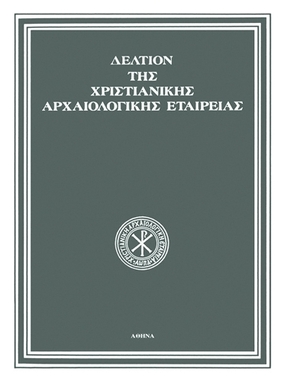Εικόνες ζωγράφων από το Λινοτόπι (16ος-17ος αιώνας) : Νέα στοιχεία και διαπιστώσεις για τη δραστηριότητά τους
Part of : Δελτίον της Χριστιανικής Αρχαιολογικής Εταιρείας ; Vol.40, 2001, pages 341-356
Issue:
Pages:
341-356
Parallel Title:
Icons by Painters from Linotopi (16th-17th Century) : New Information on their Activity
Section Title:
Articles
Abstract:
The painters from Linotopi, a village on Mt Grammos in the Prefecture of Kastoria, which was destroyed in the late eighteenth century, are known from 20 signed wall-painting ensembles, 18 of which make reference to the painters' place of origin. These works, dated between 1570 and 1656, are dispersed throughout the general area of Macedonia, southern Albania, Epirus, Thessaly and Aitolia. A number of icons, some signed by these artists and others ascribed to them, found in the churches they decorated, offer new information from which it is possible to draw conclusions about the activity of the painters from Linotopi and about the process of painting a church. The icons in question are: 1. Two despotic icons from the iconostasis, depicting Christ Pantocrator and the Enthroned Virgin and Child, and the bema doors from the katholikon of the Makrylexis monastery in the Prefecture of Ioannina, which are now housed in the Ioannina Byzantine Museum. The katholikon was decorated by Nikolaos and Michail in 1599. The inscriptions on the icons attest that they were painted by the same artists in 1593. These inscriptions also mention the hieromonks Leontios and Dimitrios, who not only dedicated the icons but also paid for the founding and painting of the church, in 1585 and 1599 respectively, as is attested by brickwork inscriptions on its exterior and the donor inscription in the interior. Some interesting conclusions can be drawn from the inscriptions as a whole. First that the two artists painted both wall-paintings and portable icons. Second that the hieromonks commissioned them to paint the icons first (which are more important from the devotional point of view) and the wall-paintings later, evidently because of financial difficulties. The six-year interval between the two commissions suggests that painters and patrons were in touch and that the latter re-engaged the former to decorate the katholikon when circumstances permitted, evidently satisfied with the quality of their work. That the Linotopi artists painted wall-paintings and portable icons and that it was common practice to commission the most important icons in a church from the artists who decorated it is borne out by the following works. 2. Part of the epistyle of an iconostasis, with a representation of the Deesis, from the church of the Dormition of the Virgin at Koukouli in the Prefecture of Ioannina, now in the Ioannina Byzantine Museum. It is signed by Konstantinos, who is also known to have executed wall-paintings in churches in Epirus and southern Albania. 3. An icon of St George and bema doors from the church of St Demetrios at Palatitsa in the Prefecture of Imathia, now in the Veroia Icon Collection. It is attributed to Nikolaos, who is mentioned in the inscription relating to the decoration of the sanctuary in 1570. 4. Three despotic icons, of the Virgin Hodegetria, Christ Pantocrator, and St Nicholas, the latter two dated 1623 and 1622, from the church of St Nicholas at Klidonia in the Prefecture of Ioannina. They are attributed to the anonymous artist who decorated the church, who has been identified as Michail from Linotopi, known from his wallpaintings in churches in Epirus and southern Albania. Signed icons by painters from Linotopi have been recognized recently on Mt Athos, in Albania, and in the Kastoria Byzantine Museum, which, in conjunction with local lore, which claim that they were brought by refugees from Linotopi, after its destruction, to towns in western Macedonia, where they settled, as well as the fact that numerous icons and wall-paintings in the Prilep area are attributed to painters from Linotopi, bear witness to their activity in this region for one hundred years or so after 1570.
Subject:
Subject (LC):




